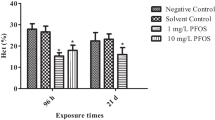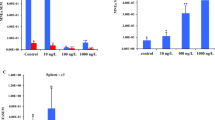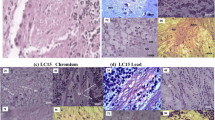Abstract
Perfluorooctanoic acid (PFOA) is an important and diffuse perfluorinated alkylated substance, but knowledge of the toxicological effects of this endocrine disrupter in fish is limited. Adult common carp Cyprinus carpio, L. were exposed to 200 ng/l (a concentration reported in impacted aquatic ecosystems) and 2 mg/l PFOA solutions in a flow-through system for 56 days to determine tissue accumulation and histological alterations of the primary target organs. PFOA was extracted from blood, gill, liver, muscle, kidney, gonad, and brain by an ion-pairing liquid extraction procedure and quantified using high performance liquid chromatography with electrospray ionization tandem mass spectrometry. The limit of detection (LOD) was 0.4 ng/g wet weight (ww). PFOA was not detectable in unexposed fish or in fish exposed to 200 ng/l, but was >LOD in most samples of carp exposed to 2 mg/l. Mean PFOA concentration ranged from 0.5 to 65 ng/g ww, depending on the tissue, with highest levels in the blood and liver. There were no significant differences in condition factor, hepato-somatic index, or gonado-somatic index among the fish of the three groups. Histological, histochemical, and immunohistochemical staining was performed on sections of liver and gonad. Occurrence of atretic oocytes and a paucity of spermatozoa were documented in carp treated with 2 mg/l PFOA. Exposed fish did not show gross hepatic anomalies, but there was enhancement of hepatocytes in proliferation (positive to anti-PCNA antibody) compared to controls.



Similar content being viewed by others
References
Abdellatif AG, Preat V, Taper HS, Robertfroid M (1991) The modulation of rat liver carcinogenesis by perfluorooctanoic acid, a peroxisome proliferator. Toxicol Appl Pharmacol 111:530–537
Ahrens L, Bundschuh M (2014) Fate and effects of poly- and perfluoroalkyl substances in the aquatic environment: a review. Environ Toxicol Chem 33:1921–1929
Ahrens L, Siebert U, Ebinghaus R (2009) Total body burden and tissue distribution of polyfluorinated compounds in harbor seals (Phoca vitulina) from the German Bight. Mar Pollut Bull 58:520–525
Ankley GT, Kuehl DW, Kahl MD, Jensen KM, Linnum A, Leino RL, Villeneuvet DA (2005) Reproductive and developmental toxicity and bioconcentration of perfluorooctanesulfonate in a partial life-cycle test with the fathead minnow (Pimephales promelas). Environ Toxicol Chem 24:2316–2324
Benninghoff AD, Bisson WH, Koch DC, Ehresman DJ, Kolluri SK, Williams DE (2011) Estrogen-like activity of perfluoroalkyl acids in vivo and interaction with human and rainbow trout estrogen receptors in vitro. Toxicol Sci 120:42–58
Bjerregaard LB, Madsen AH, Korsgaard B, Bjerregaard P (2006) Gonad histology and vitellogenin concentrations in brown trout (Salmo trutta) from Danish streams impacted by sewage effluent. Ecotoxicology 15:315–327
Blas-Machado U, Taylor HW, Means JC (2000) Apoptosis, PCNA, and p53 in Fundulus grandis fish liver after in vivo exposure to N-methyl-N′-nitro-N-nitrosoguanidine and 2-aminofluorene. Toxicol Pathol 28:601–609
Blazer VS (2002) Histopathological assessment of gonadal tissue in wild fishes. Fish Physiol Biochem 26:85–101
Consoer DM, Hoffman AD, Fitzsimmons PN, Kosian PA, Nichols JW (2014) Toxicokinetics of perfluorooctanoate (PFOA) in rainbow trout (Oncorhynchus mykiss). Aquat Toxicol 156:65–73
Cui L, Zhou QF, Liao CY, Fu JJ, Jiang GB (2009) Studies on the toxicological effects of PFOA and PFOS on rats using histological observation and chemical analysis. Arch Environ Contam Toxicol 56:338–349
Davis KL, Aucoin MD, Larsen BS, Kaiser MA, Hartten AS (2007) Transport of ammonium perfluorooctanoate in environmental media near a fluoropolymer manufacturing facility. Chemosphere 67:2011–2019
Dezfuli BS, Giari L, Lui A, Squerzanti S, Castaldelli G, Shinn AP, Manera M, Lorenzoni M (2012) Proliferative cell nuclear antigen (PCNA) expression in the intestine of Salmo trutta trutta naturally infected with an acanthocephalan. Parasites & Vectors 5:198
ECHA–European Chemicals Agency (2012) Opinions of the Committee for Risk Assessment on proposals for harmonised classification and labelling. [http://echa.europa.eu/web/guest/opinions-of-the-committee-for-riskassessment-on-proposals-for-harmonised-classification-and-labelling].
EFSA–European Food Safety Authority (2008) Perfluorooctane sulfonate (PFOS), perfluorooctanoic acid (PFOA) and their salts. Scientific Opinion of the Panel on Contaminants in the Food chain (Question N, EFSA-Q-2004-163), adopted on 21.02.008. EFSA J 653:1–131
Falk S, Failing K, Georgii S, Brunn H, Stahl T (2015) Tissue specific uptake and elimination of perfluoroalkyl acids (PFAAs) in adult rainbow trout (Oncorhynchus mykiss) after dietary exposure. Chemosphere 129:150–156
Fang X, Wei Y, Liu Y, Wang J, Dai J (2010) The identification of apolipoprotein genes in rare minnow (Gobiocypris rarus) and their expression following perfluorooctanoic acid exposure. Comp Biochem Physiol C Toxicol Pharmacol 151:152–159
Giari L, Guerranti C, Perra G, Lanzoni M, Fano EA, Castaldelli G (2015) Occurrence of perfluorooctanesulfonate and perfluorooctanoic acid and histopathology in eels from north Italian waters. Chemosphere 118:117–123
Giesy JP, Kannan K, Jones PD (2001) Global biomonitoring of perfluorinated organics. Scient World 1:627–629
Guerranti C, Perra G, Corsolini S, Focardi SE (2013) Pilot study on levels of perfluorooctane sulfonic acid (PFOS) and perfluorooctanoic acid (PFOA) in selected foodstuffs and human milk from Italy. Food Chem 140:197–203
Hagenaars A, Vergauwen L, Benoot D, Laukens K, Knapen D (2013) Mechanistic toxicity study of perfluorooctanoic acid in zebrafish suggests mitochondrial dysfunction to play a key role in PFOA toxicity. Chemosphere 91:844–856
Han J, Fang Z (2010) Estrogenic effects, reproductive impairment and developmental toxicity in ovoviparous swordtail fish (Xiphophorus helleri) exposed to perfluorooctane sulfonate (PFOS). Aquat Toxicol 99:281–290
Han X, Snow T, Kemper R, Jepson G (2003) Binding of perfluorooctanoic acid to rat and human plasma proteins. Chemic Res Toxicol 16:775–781
Hansen KJ, Johnson HO, Eldridge JS, Butenhoff JL, Dick LA (2002) Quantitative characterization of trace levels of PFOS and PFOA in the Tennessee River. Environ Sci Technol 36:1681–1685
Haramis APG, Hurlstone A, van der Velden Y, Begthel H, van den Born M, Offerhaus GJA, Clevers HC (2006) Adenomatous polyposis coli-deficient zebrafish are susceptible to digestive tract neoplasia. EMBO Rep 7:444–449
Hoff PT, Van Campenhout K, Van de Vijver K, Covaci A, Bervoets L, Moens L, Huyskens G, Goemans G, Belpaire C, Blust R, De Coen W (2005) Perfluorooctane sulfonic acid and organohalogen pollutants in liver of three freshwater fish species in Flanders (Belgium): relationships with biochemical and organismal effects. Environ Pollut 137:324–333
Houde M, De Silva AO, Muir DCG, Letcher RJ (2011) Monitoring of perfluorinated compounds in aquatic biota: an updated review. Environ Sci Technol 45:7962–7973
Inoue Y, Hashizume N, Yakata N, Murakami H, Suzuki Y, Kikushima E, Otsuka M (2012) Unique physicochemical properties of perfluorinated compounds and their bioconcentration in common carp Cyprinus carpio L. Arch Environ Contam Toxicol 62:672–680
Jobling S, Beresford N, Nolan M, Rodgers-Gray TP, Brighty G, Sumpter JP, Tyler CR (2002) Altered sexual maturation and gamete production in wild roach (Rutilus rutilus) living in rivers that receive treated sewage effluents. Biol Reprod 66:272–281
Jones PD, Hu WY, De Coen W, Newsted JL, Giesy JP (2003) Binding of perfluorinated fatty acids to serum proteins. Environ Toxicol Chem 22:2639–2649
Kim W-K, Lee S-K, Jung J (2010) Integrated assessment of biomarker responses in common carp (Cyprinus carpio) exposed to perfluorinated organic compounds. J Haz Mat 180:395–400
Kong RYC, Giesy JP, Wu RSS, Chen EXH, Chiang MWL, Lim PL, Yuen BBH, Yip BWP, Mok HOL, Au DWT (2008) Development of a marine fish model for studying in vivo molecular responses in ecotoxicology. Aquat Toxicol 86:131–141
Kudo N, Katakura M, Sato Y, Kawashima Y (2002) Sex hormone-regulated renal transport of perfluorooctanoic acid. Chem Biol Interact 139:301–316
Lee JJ, Schultz IR (2010) Sex differences in the uptake and disposition of perfluorooctanoic acid in fathead minnows after oral dosing. Environ Sci Technol 44:491–496
Leino RL, Jensen KM, Ankley GT (2005) Gonadal histology and characteristic histopathology associated with endocrine disruption in the adult fathead minnow (Pimephales promelas). Environ Toxicol Pharmacol 19:85–98
Lindstrom AB, Strynar MJ, Libelo EL (2011) Polyfluorinated compounds: past, present, and future. Environ Sci Technol 45:7954–7961
Liu C, Du Y, Zhou B (2007) Evaluation of estrogenic activities and mechanism of action of perfluorinated chemicals determined by vitellogenin induction in primary cultured tilapia hepatocytes. Aquat Toxicol 85:267–277
Liu Y, Wang J, Liu Y, Zhang H, Xu M, Dai J (2009) Expression of a novel cytochrome P450 4T gene in rare minnow (Gobiocypris rarus) following perfluorooctanoic acid exposure. Comp Biochem Physiol, part C 150:57–64
Loos R, Locoro G, Huber T, Wollgast J, Christoph EH, de Jager A, Gawlik BM, Hanke G, Umlauf G, Zaldívar J-M (2008) Analysis of perfluorooctanoate (PFOA) and other perfluorinated compounds (PFCs) in the river Po watershed in N-Italy. Chemosphere 71:306–313
Loos R, Gawlik BM, Locoro G, Rimaviciute E, Contini S, Bidoglio G (2009) EU-wide survey of polar organic persistent pollutants in European river waters. Environ Pollut 157:561–568
Martin JW, Mabury SA, Solomon KR, Muir DCG (2003a) Bioconcentration and tissue distribution of perfluorinated acids in rainbow trout (Oncorhynchus mykiss). Environ Toxicol Chem 22:196–204.
Martin JW, Mabury SA, Solomon KR, Muir DCG (2003b) Dietary accumulation of perfluorinated acids in juvenile rainbow trout (Oncorhynchus mykiss). Environ Toxicol Chem 22:189–195.
Martin JW, Whittle DM, Muir DC, Mabury SA (2004) Perfluoroalkyl contaminants in a food web from Lake Ontario. Environ Sci Technol 38:5379–5385
McLachlan MS, Holmstrom KE, Reth M, Berger U (2007) Riverine discharge of perfluorinated carboxylates from the European continent. Environ Sci Technol 41:7260–7265
Myers MS, Johnson LL, Hom T, Collier TK, Stein JE, Varanasi U (1998) Toxicopathic lesions in subadult English sole (Pleuronectes vetulus) from Puget Sound, Washington, USA: relationships with other biomarkers of contaminant exposure. Mar Environ Res 45:47–67
Nania V, Pellegrini GE, Fabrizi L, Sesta G, De Sanctis P, Lucchetti D, Di Pasquale M, Coni E (2009) Monitoring of perfluorinated compounds in edible fish from the Mediterranean Sea. Food Chem 115:951–957
Ng CA, Hungerbuhler K (2013) Bioconcentration of perfluorinated alkyl acids: how important is specific binding? Environ Sci Technol 47:7214–7223
Oakes KD, Sibley PK, Martin JW, Solomon KR, Mabury SA, Kraak GLVD (2004) Impact of perfluorooctanoic acid on fathead minnow (Pimephales promelas) fatty acyl-CoA oxidase activity, circulating steroids, and reproduction in outdoor microcosms. Environ Toxicol Chem 23:1912–1919
OECD-Organization for Economic Cooperation, Development (1996) Guidelines for testing of chemicals, guideline 305, bioconcentration: flow-through fish test. Organization for Economic Cooperation and Development, Paris
Ortego LS, Hawkins WE, Walker WW, Krol RM, Benson WH (1994) Detection of proliferating cell nuclear antigen in tissues of three small fish species. Biotech Histochem 69:317–323
Ortego LS, Hawkins WE, Walker WW, Krol RM, Benson WH (1995) Immunohistochemical detection of proliferating cell nuclear antigen (PCNA) in tissues of aquatic animals utilized in toxicity bioassays. Mar Environ Res 39:271–273
Peng H, Wei Q, Wan Y, Giesy JP, Li L, Hu J (2010) Tissue distribution and maternal transfer of poly- and perfluorinated compounds in Chinese sturgeon (Acipenser sinensis): implications for reproductive risk. Environ Sci Technol 44:1868–1874
Post GB, Cohn PD, Cooper KR (2012) Perfluorooctanoic acid (PFOA), an emerging drinking water contaminant: a critical review of recent literature. Environ Res 116:93–117
Prevedouros K, Cousins IT, Buck RC, Korzeniowski SH (2006) Sources, fate and transport of perfluorocarboxylates. Environ Sci Technol 40:32–44
Seacat AM, Thomford PJ, Hansen KJ, Clemen LA, Eldridge SR, Elcombe CR, Butenhoff JL (2003) Sub-chronic dietary toxicity of potassium perfluorooctanesulfonate in rats. Toxicology 183:117–131
Sijm D, van der Linde A (1995) Size-dependent bioconcentration kinetics of hydrophobic organic chemicals in fish based on diffusive mass transfer and allometric relationships. Environ Sci Technol 29:2769–2777
Suja F, Pramanik BK, Zain SM (2009) Contamination, bioaccumulation and toxic effects of perfluorinated chemicals (PFCs) in the water environment: a review paper. Water Sci Technol 60:1533–1544
Sumi M, Kawashima Y, Fukumaki T, Ishibashi H, Arizono K, Iguchi T, Shimizu M (2007) Comparison of serum vitellogenin, steroid hormone, gonad histopathology and bioaccumulation in common carp (Cyprinus carpio) of two rivers and a lake in Japan: potential for endocrine disruption. Environ Sci 14:41–54
Tanna RN, Tetreault GR, Bennett CJ, Smith BM, Bragg LM, Oakes KD, McMaster ME, Servos MR (2013) Occurrence and degree of intersex (testis-ova) in darters (Etheostoma SPP.) across an urban gradient in the Grand River, Ontario, Canada. Environ Toxicol Chem 32:1981–1991
Thophon S, Pokethitiyook P, Chalermwat K, Upatham E, Sahaphong S (2004) Ultrastructural alterations in the liver and kidney of white seabass, in acute and subchronic cadmium exposure. Environ Toxicol 19:11–19
Tilton SC, Orner GA, Benninghoff AD, Carpenter HM, Hendricks JD, Pereira CB, Williams DE (2008) Genomic profiling reveals an alternate mechanism for hepatic tumor promotion by perfluorooctanoic acid in rainbow trout. Environ Health Persp 116:1047–1055
van der Oost R, Beyer J, Vermeulen NPE (2003) Fish bioaccumulation and biomarkers in environmental risk assessment: a review. Environ Toxicol Pharmacol 13:57–149
Vanden Heuvel JP, Davis JW, Sommers R, Peterson RE (2006) Renal excretion of perfluorooctanoic acid in male rats: inhibitory effect of testosterone. J Biochem Toxicol 7:31–36
Wei Y, Dai J, Liu M, Wang J, Xu M, Zha J, Wang Z (2007) Estrogen-like properties of perfluorooctanoic acid as revealed by expressing hepatic estrogen-responsive genes in rare minnows (Gobiocypris rarus). Environ Toxicol Chem 26:2440–2447
Wei Y, Chan LL, Wang D, Zhang H, Wang J, Dai J (2008a) Proteomic analysis of hepatic protein profiles in rare minnow (Gobiocypris rarus) exposed to perfluorooctanoic acid. J Proteome Res 7:1729–1739.
Wei Y, Liu Y, Wang J, Tao Y, Dai J (2008b) Toxicogenomic analysis of the hepatic effects of perfluorooctanoic acid on rare minnows (Gobiocypris rarus). Toxicol Appl Pharmacol 226:285–297.
Wester PW, van der Ven LTM, Vethaak AD, Grinwis GCM, Vos JG (2002) Aquatic toxicology: opportunities for enhancement through histopathology. Environ Toxicol Pharmacol 11:289–295
White SS, Fenton SE, Hines EP (2011) Endocrine disrupting properties of perfluorooctanoic acid. J Steroid Biochem 127:16–26
Yan S, Zhang H, Zheng F, Sheng N, Guo X, Dai J (2015) Perfluorooctanoic acid exposure for 28 days affects glucose homeostasis and induces insulin hypersensitivity in mice. Scien Rep 5:11029
Yang J-H (2010) Perfluorooctanoic acid induces peroxisomal fatty acid oxidation and cytokine expression in the liver of male Japanese medaka (Oryzias latipes). Chemosphere 81:548–552
Ye X, Schoenfuss HL, Jahns ND, Delinsky AD, Strynar MJ, Varns J, Nakayama SF, Helfant L, Lindstrom AB (2008a) Perfluorinated compounds in common carp (Cyprinus carpio) fillets from the Upper Mississippi River. Environ Int 34:932–938.
Ye X, Strynar MJ, Nakayama SF, Varns J, Helfant L, Lazorchak J, Lindstrom AB (2008b) Perfluorinated compounds in whole fish homogenates from the Ohio, Missouri, and Upper Mississippi Rivers. USA. Environ Pollut 156:1227–1232.
Yoo H, Guruge KS, Yamanaka N, Sato C, Mikami O, Miyazaki S, Yamashita N, Giesy JP (2009) Depuration kinetics and tissue disposition of PFOA and PFOS in white leghorn chickens (Gallus gallus) administered by subcutaneous implantation. Ecotox Environ Safe 72:26–36
Zhang H, Lu J, Luo B, Yan S, Guo X, Dai J (2014) Proteomic analysis of mouse testis reveals mice perfluorooctanoic acid-induced reproductive dysfunction via direct disturbance of testicular steroidogenic machinery. J Proteome Res 13:3370–3385
Acknowledgments
Thanks are due to Dr. Mattia Lanzoni, Dr. Alice Lui, Dr. Samantha Squerzanti, Dr. Chiara Clementini, and Dr. Eugenia Passanisi for their technical help, to Dr. Maurizio Manera for statistical advice, to The Lucidus Consultancy for English correction of the manuscript. Part of this investigation was supported by grants from HERA Ferrara, and we are grateful in particular to Eng. Francesco Maffini and Mr. Massimo Mari.
Author information
Authors and Affiliations
Corresponding author
Ethics declarations
Conflict of interest
The authors declare that they have no conflict of interest.
Additional information
Responsible editor: Henner Hollert
Rights and permissions
About this article
Cite this article
Giari, L., Vincenzi, F., Badini, S. et al. Common carp Cyprinus carpio responses to sub-chronic exposure to perfluorooctanoic acid. Environ Sci Pollut Res 23, 15321–15330 (2016). https://doi.org/10.1007/s11356-016-6706-1
Received:
Accepted:
Published:
Issue Date:
DOI: https://doi.org/10.1007/s11356-016-6706-1




